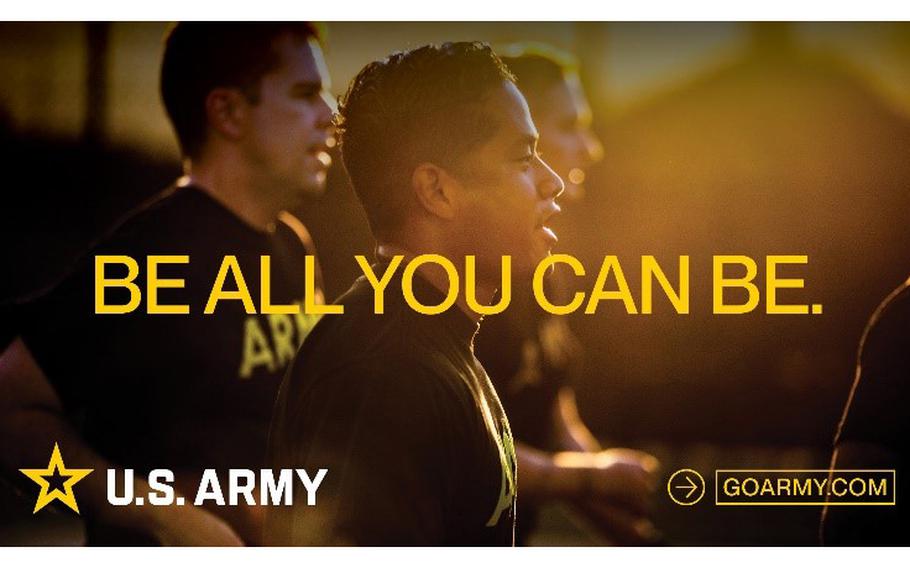
The Army will launch a new marketing campaign next year built around the old slogan, “Be All You Can Be,” which was used in Army advertising from about 1981 to 2001. As part of the rebranding, Army marketers redesigned the service’s star logo to appear clearer online. (U.S. Army)
The Army will launch a new advertising campaign next year that uses an old slogan to attract young audiences to the service — “Be All You Can Be.”
While that sounds familiar to anyone who watched television in the 1980s and 1990s, the slogan best relays the “possibilities” that await a new Army recruit, said Maj. Gen. Alex Fink, chief of Army enterprise marketing.
“We're not returning to ‘Be All You Can Be’ for nostalgia or old times’ sake or because we think retro is trendy and cool. We're really reinventing it to reposition the Army and to inspire the next generation soldiers,” Fink said.
The last “Be All You Can Be” ad ran on TV in January 2001, and most of the audience the Army is trying to reach now weren’t born then. The ads of the original campaign focused on pride and often included a voiceover of the soldier’s creed.
Fink declined to discuss exactly what new television ads could be coming through the campaign, but he said the concept is meant to showcase possibility and opportunity that’s available to those who choose to enlist, regardless of whether they want a full career in the Army or just enough time to leverage themselves into a college education or a specific civilian career field.
Fink said his own life story speaks to the possibilities available in the Army. A self-described farm kid from Missouri with just 19 kids in his graduating high school class, he went on to become a two-star general officer in the Army Reserve. He took over the Army’s top marketing job in August 2019, just as the service established the separate Chicago-based office to manage its national campaigns.
Young people today find the ideas of community, connection, purpose and passion to be important to them, Fink said, and the Army offers all of that. However, the Army’s messaging really hasn’t shown it. Instead, it has focused on what people already know about the Army, which is that it takes courage and toughness.
A television ad for the current Army recruiting campaign — “What’s your warrior?” — features a wordless montage of pilots in combat, scientists splitting cells, snipers in ghillie suits, air defense systems, and parachutists, all set to a bass-heavy remix of the band Chicago’s “25 or 6 to 4.” Most soldiers are shown isolated or working alone.
“We already get credit for all that stuff through the media through movie franchises,” Fink said. “Let’s lean into things that they don't know.”
After doing audience testing and research on about 200 different taglines, “Be All You Can Be” was a clear winner with each demographic, Fink said. It appealed to young people, as well as those likely to influence a person’s decision to join the Army, and veterans of the service.
When the first “Be All You Can Be” ads aired in 1981 during college football bowl games, it was the first time the all-volunteer Army had been sold to the public in the same way that advertising agencies sold toothpaste or soda. Veterans had a difficult time adjusting, according to the Army Historical Foundation.
In one ad, a soldier takes a call from his parents who have recently purchased a home computer and offers advice from his Army training on how to link it to a printer. In another ad, a woman credits her high school coach and her parents for building her confidence to push herself in the Army.
All the early ads end with a jingle written by songwriter Jake Holmes, “Be all that you can be, find your future, in the Army.” While the jingle disappeared from later commercials, the tagline remained until it was replaced with “Army of One.” Later, the Army moved to “Army strong.”
The magazine Advertising Age, which ranked “Be All You Can Be” as No. 18 in the top 100 campaigns of the 20th century, described the ads as hitting a bull’s-eye for appealing to high school dropouts and graduates.
At that time in the Army’s history, similar to now, the service was in a recruiting slump. The service failed to meet its recruiting goal by about 15,000 soldiers in fiscal 2022, which ended Sept. 30. Fink said he and his team began conceptualizing this new campaign back in March 2020 before recruiting became a problem.
He also said the shift away from warrior-centric ads has nothing to do with the end of the wars in Iraq and Afghanistan. However, he said he believes that could have influenced people’s opinions during market research.
“We're trying to establish a brand refresh that's going to last for a long time,” Fink said. “If we do this well, we think this could last for 15 to 20 years or more.”
Senior Army leaders have already approved the slogan, and the timeline for “Be All You Can Be” to officially launch in March. Included in the new marketing materials is an updated Army star logo that is better suited for social media and digital advertising.
Fink did not have a timeline for when viewers could expect to see the new TV ads.